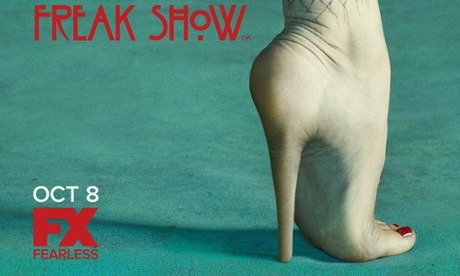
The new season of the popular U.S TV show ‘American Horror Story’ hits our British shores on 21st October, over on FX, in time to get us excited for Halloween. For those unfamiliar with the concept, ‘Freakshow’ is the 4th season of the AHS franchise which started in 2011, reusing the same cast over again but always with a different setting and storyline. Previous seasons themes include ‘Asylum,’ ‘Coven’ and a haunted house all designed to be creepy, sexual, funny and very different to anything else out there right now.
However, this upcoming cycles content has ruffled some feathers within the disabled community, and it’s not hard to see why. ‘AHS: Freakshow’ is set in 1950’s Florida centering on a group of people with obvious physical disabilities banded together in one of America’s last ‘freak’ shows. Some actors playing these roles are genuinely disabled, such as the worlds smallest woman Jyoti Amge, and others not, where recurring actress Sarah Paulson plays conjoined twins.
The use of the archaic word ‘Freak’ serves as a useful reminder to us of the terms that have come and gone, much like racially prejudiced terms, that are no longer acceptable in the modern PC age. This is a credit to our society, to recognise as a whole that these terms along with ‘crippled’ and ‘handicapped,’ are no longer acceptable; yet it is also unnerving to see published so brazenly again. As Howard Sherman puts it in his ‘Guardian’ article on this topic, ‘[freak] is a slur – and though it might be accurately portrayed on screen or on stage, it’s not yours to reclaim for someone else, even characters in a show.’
Especially when paired with the series promo poster, a ghostly looking misshapen foot next to the title ‘Freakshow’ (see above), gives the impression that we are to fear and gawp at. This is, after all, supposed to be the portrayal of a ‘horror story.’ Yet, what precisely is so ‘horrific’ about the disabled form?
After watching the first episode, it is apparent that the ‘freaks’ are supposed to provoke a feeling of unease in the viewer, yet they are also built up as multi dimensional characters. But this privilege is mostly enjoyed by the non-disabled actors playing disabled roles. Jyoti Amge, a 20 year old woman with achondroplasia, is permitted just a few lines in a bit part that is doubtful to last the whole season. Additionally, she is routinely picked up and carried around by cast members, fueling the infantilization of those with small stature. It does, frankly, reek of objectification.
Regardless, this popular television show has decided to put disability, and how those with disabilities used to be treated so callously not all that long ago, at its forefront. ‘Freakshow’s’ were something that happened in society, and to ignore that fact in popular culture would be the same as claiming it never existed.

I wrote my Masters dissertation on the Victorian Freak Show and the commodification of the disabled body; as a disabled person with Ehlers-Danlos Syndrome Type III, (I’m very bendy and suffer chronic pain) I found it incredibly interesting as had I lived a hundred years previously I would have no doubt performed in said shows. I’m an avid lover of ‘American Horror Story’ and was intrigued when I found out that the fourth season would be the Freak Show as I wondered how the disabled body would be shown. What I found impressive thoughout the series was how the ablebodied characters were more monstrous than the ‘freaks’.